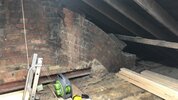- Joined
- 28 Dec 2024
- Messages
- 8
- Reaction score
- 0
- Country

I am in the process of boarding the loft and adding some extra insulation to my ~1900s terraced property. It appears to have had some kind of modification/support made to the chimney stack, and that is what is being supported by this steel RSJ that partially blocks my loft hatch.
Unfortunately, on the wall directly by the loft hatch, there are some very badly crumbling bricks. Others are rock solid. Every time I open the loft hatch, bits of the bricks fall down, especially if it's been a while since I was last up there. Given that there is carpet under the hatch, I have to put down a tarp when I open the loft hatch or else the red brick dust stains the carpet and it is very frustrating.
I have tried applying PVA solution and it held them together a bit but it's still very crumbly and the application of the PVA itself caused even more crumbling in the process. Video attached shows the assortment of crumbling bricks and some tapping on nearby ones to show how solid they are by comparison.
Is there a treatment I can apply to stabilise these properly, maybe a sealant? Or can I just plaster over the top? Or do I need to remove the crumbled bricks and replace them individually? Why is this happening?
Thank you!

Unfortunately, on the wall directly by the loft hatch, there are some very badly crumbling bricks. Others are rock solid. Every time I open the loft hatch, bits of the bricks fall down, especially if it's been a while since I was last up there. Given that there is carpet under the hatch, I have to put down a tarp when I open the loft hatch or else the red brick dust stains the carpet and it is very frustrating.
I have tried applying PVA solution and it held them together a bit but it's still very crumbly and the application of the PVA itself caused even more crumbling in the process. Video attached shows the assortment of crumbling bricks and some tapping on nearby ones to show how solid they are by comparison.
Is there a treatment I can apply to stabilise these properly, maybe a sealant? Or can I just plaster over the top? Or do I need to remove the crumbled bricks and replace them individually? Why is this happening?
Thank you!

